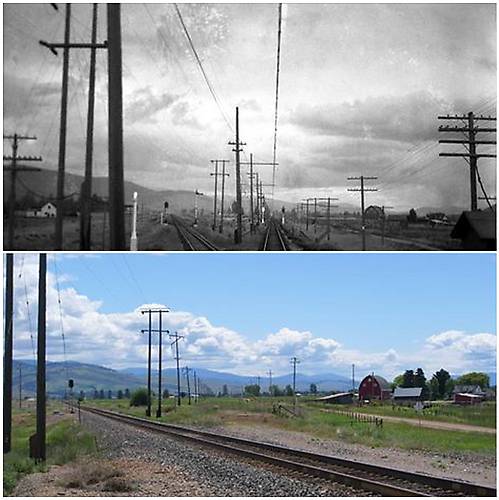Abandoned Milwaukee Road before-and-after pictures Huson, MT
By Steve McCollum; posted September 14, 2014
View Original: Click to zoom, then click to magnify (832 x 833) 1091KB

|
This might be an excellent example of using foreknowledge to explore an abandoned ROW for insulators. I wonder if any were thrown into the pole holes when the trackside wires were removed? This appeared in the "Abandoned Rails" group on Facebook, posted by J Andrew Severs. Carefully compare the before and after pictures. There is a signal that appears in both, as do the two H-shaped power poles. . Here is the original text that accompanied the pictures. Huson, Montana is located 20 miles west of Missoula and was a major crossing of the Milwaukee Road and Northern Pacific Railroad. John W. Barriger III was traveling west on the Milwaukee in 1936 when he snapped the B&W photo of the railroad diamond, farm house, barn and various out buildings. Forward 77 years and the farm house and buildings have outlived the Milwaukee Road, the Northern Pacific and the railroad diamond. The Milwaukee was gone in 1980; the diamond removed shortly thereafter, the NP is now Montana Rail Link. The farm looks amazingly well kept! Brent Burger later responded: Great photo of the old Milwaukee. The bad news was that buyers for the Pacific Extension project anticipated insulator collectors by 50 years and made sure little-to-nothing they bought would ever be of interest to collectors. Add to that, when the scrappers came through, they took the poles apart, stripping the metal and giving the poles to local ranchers. The insulators ended up in enormous piles literally 40 feet across, 2-3 hundred feet long, and as high at they would heap without collapsing the pile. The two collection points I had the chance to see were later moved and buried. It was not a gentle process and few survived. Still, it was railroad and the Milwaukee was perversely attractive for its state of dereliction. Great photo. As an aside, the eastern part of the Pacific Extension did give up some more interesting stuff. Nothing too earthshaking, but cool, just the same. I have a zinger late-Bushwick yellow-green 164 BF off their line that saw use in eastern MT. My brother has a swirly-jaded 151 HG from the same area of the Milwaukee. But out west, it was ZILLIONS of aqua H-top HG 145's, 42's, and other "thrilling" stuff. The piece I really came to love off that line was the more yellow glazed Pittsburgh beehives. We found a WAD of them right around Cabin Creek and a few other scattered widely around the system. Most were dark brown or the reddish "mahogany" brown, but the occasional example was quite pretty. I must have a dozen of them I have saved over the years. In a rebuild along the Black River, west of Renton, the line was well populated with clear and blue Hemi-21 beehives and those lightly carnivalized Armstrong 155's. I found the beehives to be a queerly interesting design for such an old style. The beehive dates to 1884 (at least) and was pretty much obsolete as a current style by 1912, yet these were still made into the late 30's! I brought one of the 155's home, but the modern design wretched me out and I am sure it ended up in our insulator dump. Still have the other two beehives though. |